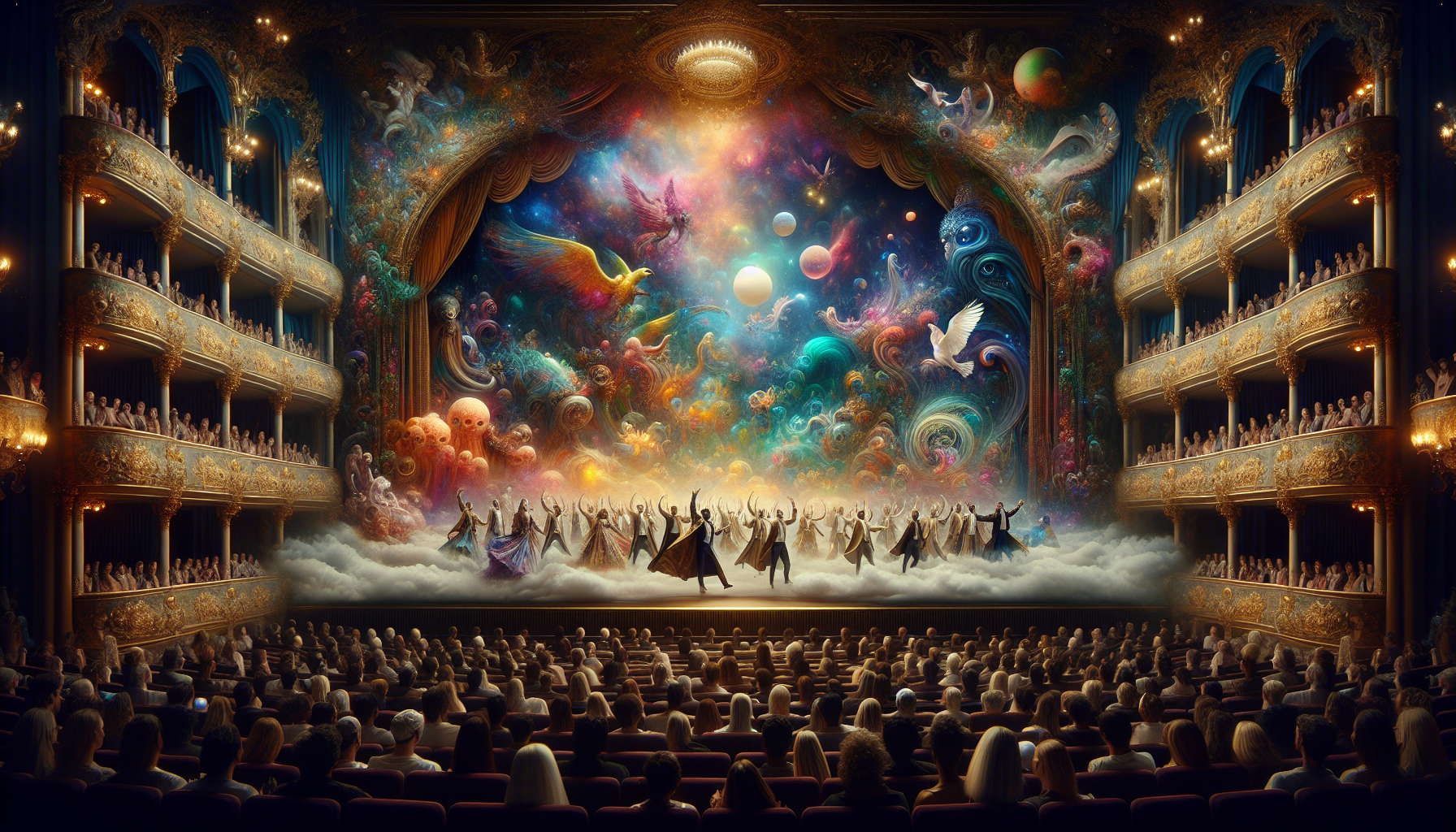In a world increasingly characterized by individual pursuits and personal ambitions, there lies an often-overlooked yet profoundly transformative phenomenon: the power of collective dreams. Imagine a group of individuals, each with their unique aspirations, coming together to share their visions and experiences. What emerges is not just a collaboration of ideas but a powerful synergy that can transcend the limits of personal ambition and spark revolutionary change. This concept of collective dreaming—a shared vision that fuels group dynamics and propels communal efforts—serves as a compelling reminder that, together, we can achieve the extraordinary. 🌟
The idea of collective dreams is not new; history is peppered with examples of movements and innovations born from shared visions. From the civil rights movements that reshaped societal structures to the technological advances that have revolutionized our way of living, these collective endeavors demonstrate how group experiences can harness the power of shared aspirations to create lasting impact. Yet, despite its significance, the nuanced dynamics of collective dreaming often remain unexplored. This article aims to delve into the essence of shared visions, unraveling how they are formed, nurtured, and ultimately realized within group experiences.
As we embark on this exploration, we will first examine the psychology behind collective dreams. Understanding what motivates individuals to align their personal goals with those of a group is crucial. What drives people to set aside their individual pursuits in favor of a collective vision? Is it the promise of a greater good, the allure of belonging to something bigger than oneself, or the intrinsic satisfaction derived from collaboration? By delving into these questions, we uncover the psychological underpinnings that fuel collective dreams and explore how they shape group dynamics.
Furthermore, we will investigate the role of leadership in orchestrating these shared visions. Effective leadership can make or break the realization of a collective dream. By analyzing different leadership styles and their impact on group cohesion, we will identify the qualities that enable leaders to inspire and mobilize individuals towards a common goal. Whether it’s a charismatic figurehead or a more democratic approach, the capacity to cultivate a shared vision hinges on the ability to connect with and empower group members. Leadership, in this context, becomes an art form—one that demands empathy, foresight, and an unwavering commitment to the collective dream.
Finally, we will explore real-world examples of collective dreams in action, showcasing how shared visions have driven transformative outcomes in various domains. From community projects that have revitalized urban spaces to collaborative artistic endeavors that have redefined cultural landscapes, these case studies will illuminate the tangible impact of collective dreams. Through these narratives, we will draw lessons and insights that can inspire and guide future endeavors, proving that when individuals unite under a common vision, the possibilities are limitless.
In this journey through the realm of collective dreams, we invite you to reflect on your own experiences and consider the potential of shared visions in your personal and professional life. Whether you’re part of a team striving for innovation, a community advocating for change, or an individual seeking to contribute to a larger cause, the power of collective dreams is within your reach. Together, let’s unveil the extraordinary potential of shared visions and discover how they can transform not only our lives but the world around us. 🌍
The Concept of Collective Dreams
In the realm of human experience, dreams have long fascinated us, often seen as mysterious and deeply personal voyages of the subconscious. Yet, when these dreams become collective, they evolve into powerful shared visions that can influence and shape entire communities. The concept of collective dreams refers to the shared aspirations, ambitions, and visions that groups of people hold together, often leading to significant social and cultural impacts.
Historically, collective dreams have played pivotal roles in shaping societies. These dreams often manifest through movements and revolutions where a large group of people is driven by a shared vision for a better future. The Civil Rights Movement in the United States, for example, was driven by the collective dream of equality and justice. Similarly, the Indian independence movement was fueled by the shared vision of freedom from colonial rule. These collective dreams provide a sense of purpose and unity, motivating individuals to work together towards common goals.
The psychological basis for collective dreams can be found in Carl Jung’s theory of the collective unconscious, which suggests that people share a set of primal memories and ideas. This theory posits that certain symbols and archetypes are common across different cultures, facilitating a shared understanding and common aspirations. Collective dreams tap into this shared unconscious, creating a powerful bond among individuals. The internet and social media have further amplified the reach and impact of these dreams, enabling them to transcend geographical boundaries and cultural differences.
The Power of Shared Visions
Shared visions are powerful catalysts for change, as they unify individuals under a common purpose, fostering collaboration and innovation. In organizational settings, shared visions are critical for success, aligning employees with the company’s goals and strategies. They provide direction and inspiration, motivating teams to achieve extraordinary results. When employees share a vision, they are more likely to be engaged, productive, and committed to the organization’s success.
For example, in companies like Google and Apple, shared visions have driven innovation and growth. These organizations have been able to cultivate environments where employees are encouraged to think creatively and push boundaries, all in pursuit of a collective dream of technological advancement and innovation. This not only enhances employee satisfaction but also contributes to the company’s competitive edge in the market.
Beyond the corporate world, shared visions have the power to drive social change. Non-profit organizations and social movements often revolve around shared visions that address social injustices and inequalities. The success of these movements often hinges on their ability to communicate and spread their vision effectively, galvanizing public support and driving legislative change. A clear and compelling vision can inspire action and bring about significant societal transformations.
Table: Examples of Collective Dreams and Their Impact
| Collective Dream | Impact |
|---|---|
| Civil Rights Movement | Advancements in equality and anti-discrimination laws in the United States. |
| Indian Independence Movement | End of British colonial rule and establishment of India as an independent nation. |
| Environmental Activism | Increased awareness and policy changes regarding climate change and environmental protection. |
For a deeper understanding of the role of shared visions in driving collective action, watch this insightful video: “The Power of Vision” – Motivational Channel.
Group Dynamics and the Formation of Collective Dreams
Understanding group dynamics is crucial to comprehending how collective dreams are formed and sustained. Group dynamics refer to the interactions and psychological processes that occur within a social group. These dynamics can influence the group’s ability to form and pursue collective dreams, as they impact communication, decision-making, and conflict resolution within the group.
One key element in the formation of collective dreams is effective communication. Open and transparent communication channels enable group members to express their ideas, share their aspirations, and build a shared understanding of their goals. This facilitates the creation of a cohesive vision that everyone is committed to. Furthermore, inclusive leadership plays a significant role in fostering a culture of collaboration and trust, where every member feels valued and heard.
Decision-making processes are also vital in the pursuit of collective dreams. Groups that utilize participatory decision-making approaches are more likely to create collective dreams that reflect the diverse perspectives and values of their members. This inclusivity not only strengthens the commitment to the shared vision but also enhances the group’s resilience and adaptability in the face of challenges.
Key Factors in Successful Group Dynamics
- Communication: Ensures transparency and shared understanding.
- Leadership: Encourages inclusivity and collaboration.
- Decision-making: Involves participatory approaches to reflect diverse perspectives.
To see an example of how group dynamics influence the formation of collective dreams, check out this video: “Understanding Group Dynamics” – Psychology Insights.
Challenges and Opportunities in Realizing Collective Dreams
While the potential of collective dreams is immense, realizing these dreams often presents several challenges. Conflicting interests, resource limitations, and external opposition can impede progress. However, these challenges also present opportunities for growth, innovation, and strengthening of the collective vision.
Conflicting interests within a group can lead to fragmentation and hinder the pursuit of collective dreams. These conflicts often arise from differences in individual values, priorities, and expectations. Effective conflict resolution strategies, such as mediation and negotiation, are essential for overcoming these challenges. Additionally, fostering a culture of empathy and understanding can help bridge divides and strengthen the group’s commitment to their shared vision.
Resource limitations, such as financial constraints and lack of expertise, can also pose significant obstacles. However, these challenges can be addressed through strategic partnerships, community support, and leveraging technology and innovation. Crowdfunding, for instance, has become a powerful tool for groups to mobilize resources and support their collective dreams. Collaborative efforts with other organizations and communities can also enhance resource availability and knowledge sharing.
Table: Challenges and Opportunities in Collective Dreams
| Challenges | Opportunities |
|---|---|
| Conflicting Interests | Promoting empathy and conflict resolution strategies. |
| Resource Limitations | Leveraging partnerships and technology for resource mobilization. |
| External Opposition | Building alliances and increasing advocacy efforts. |
External opposition, such as political resistance or societal skepticism, can also pose challenges. However, these obstacles can be transformed into opportunities for advocacy and awareness-building. Effective communication and strategic campaigning can help garner public support and challenge entrenched systems of power, ultimately paving the way for the realization of collective dreams.
In conclusion, while collective dreams present significant challenges, they also offer numerous opportunities for innovation, collaboration, and societal transformation. By understanding group dynamics, fostering effective communication, and leveraging available resources, groups can overcome these challenges and work towards achieving their shared visions. As we continue to navigate an increasingly interconnected world, the power of collective dreams remains an essential driver of positive change and progress. 🌟

Conclusion
Conclusion: Harnessing the Power of Collective Dreams in Group Experiences
In our exploration of “Collective Dreams: Unveiling the Power of Shared Visions in Group Experiences,” we embarked on a journey through the multifaceted world of shared visions and their profound impact on group dynamics. Throughout this article, we examined the intricacies of how collective dreams can transform ordinary group interactions into extraordinary experiences that foster collaboration, innovation, and deep human connections.
At the outset, we delved into the fundamental concept of collective dreams, highlighting their role in uniting individuals toward common goals. We explored how these shared visions are not merely figments of imagination but powerful drivers that propel groups towards success. By examining various case studies and examples, we illustrated how organizations and communities have harnessed the power of collective dreams to achieve remarkable outcomes. From the collaborative efforts of tech giants to grassroots movements that sparked societal change, the evidence is clear: when people come together under a shared vision, the possibilities are boundless.
One of the key points we discussed is the psychological aspect of collective dreaming. We looked into how shared visions tap into the innate human desire for connection and belonging. By engaging in collective dreaming, individuals find purpose and motivation, as they become part of something greater than themselves. This sense of belonging not only enhances individual satisfaction but also strengthens group cohesion, making teams more resilient in the face of challenges.
Furthermore, we examined the role of leadership in cultivating and sustaining collective dreams. Effective leaders, we noted, are those who can articulate a compelling vision and inspire others to buy into that vision. Through strong communication skills and emotional intelligence, leaders can align diverse perspectives and guide their teams toward shared objectives. We discussed how leaders who embrace collective dreaming create environments where innovation thrives and individuals feel empowered to contribute their unique talents.
The article also shed light on the practical strategies for fostering collective dreams within groups. We explored techniques such as vision workshops, collaborative brainstorming sessions, and open forums for dialogue, all of which encourage participation and creativity. By providing a platform for individuals to express their ideas and aspirations, groups can tap into a wealth of untapped potential, driving innovation and progress.
In addition to organizational settings, we considered the broader societal implications of collective dreaming. We reflected on historical movements where shared visions galvanized communities to challenge the status quo and bring about transformative change. These examples underscore the potential of collective dreams to address complex social issues and inspire action on a global scale.
In reinforcing the importance of this theme, it’s crucial to recognize that collective dreams are not a one-time phenomenon but an ongoing process. The dynamic nature of shared visions requires continuous nurturing and adaptation. Groups must remain open to new ideas, embrace diversity, and foster an inclusive culture that values every voice. By doing so, they can sustain the momentum of collective dreaming and achieve long-lasting impact.
As we conclude, I invite you, dear reader, to reflect on the power of collective dreams in your own life. Consider how shared visions have influenced your experiences within groups, whether in professional settings, community organizations, or personal endeavors. How can you contribute to nurturing and realizing these visions? How can you inspire others to join you in this journey?
I encourage you to share your thoughts and experiences in the comments section below. Let’s continue this dialogue and learn from one another. Moreover, consider sharing this article with colleagues, friends, or anyone who might benefit from understanding the transformative potential of collective dreams. By spreading the word, you can play a part in fostering a culture of collaboration and innovation.
In conclusion, collective dreams hold the key to unlocking the full potential of group experiences. They remind us that, together, we can achieve the extraordinary. By embracing shared visions, we can create a world where collaboration knows no bounds, and dreams become reality. Let’s dream big, dream together, and turn our collective aspirations into a powerful force for positive change. 🌟
For further reading on the topic of collective dreams and group dynamics, consider exploring resources such as Harvard Business Review and Stanford Social Innovation Review. These platforms offer valuable insights into leadership, innovation, and the power of collaboration.
Thank you for joining us on this journey of discovery. Let’s continue to dream collectively and inspire the world.
Gabriel is a visual storyteller and dream archivist whose work explores the fragile boundary between memory and imagination. Through layered visuals and symbolic design, Gabriel captures the fleeting essence of dreams — those strange, beautiful, and sometimes haunting fragments that drift through sleep and linger in waking thought.
His creative journey is rooted in a deep fascination with the subconscious and the imagery it conjures. From half-remembered landscapes to recurring symbols and surreal encounters, each piece Gabriel brings to life becomes a portal into the inner archive — where time distorts, meanings shift, and personal mythology takes form.
With a background in handcrafted artistry and visual composition, Gabriel merges intuition with intention. His work doesn’t merely depict dreams; it preserves them, translating ephemeral moments into tangible expressions that evoke emotion, curiosity, and quiet revelation. Each visual is both a record and an invitation to explore the rich terrain of inner life.
Through illustrated dream journals, symbolic studies, and visual essays, Gabriel invites others to connect with the poetic architecture of their subconscious landscapes. His art becomes a mirror — not only of what we see at night, but of what we carry deep within.
His work is a tribute to:
-
The fragile beauty of forgotten dreams
-
The language of symbols in the subconscious mind
-
The inner worlds we visit but rarely name
Whether you’re a lucid dreamer, a seeker of hidden meanings, or someone fascinated by the mystery of sleep-born stories, Gabriel welcomes you to step into a space where dreams are not lost — they are archived, one vision, one sketch, one silent narrative at a time.





